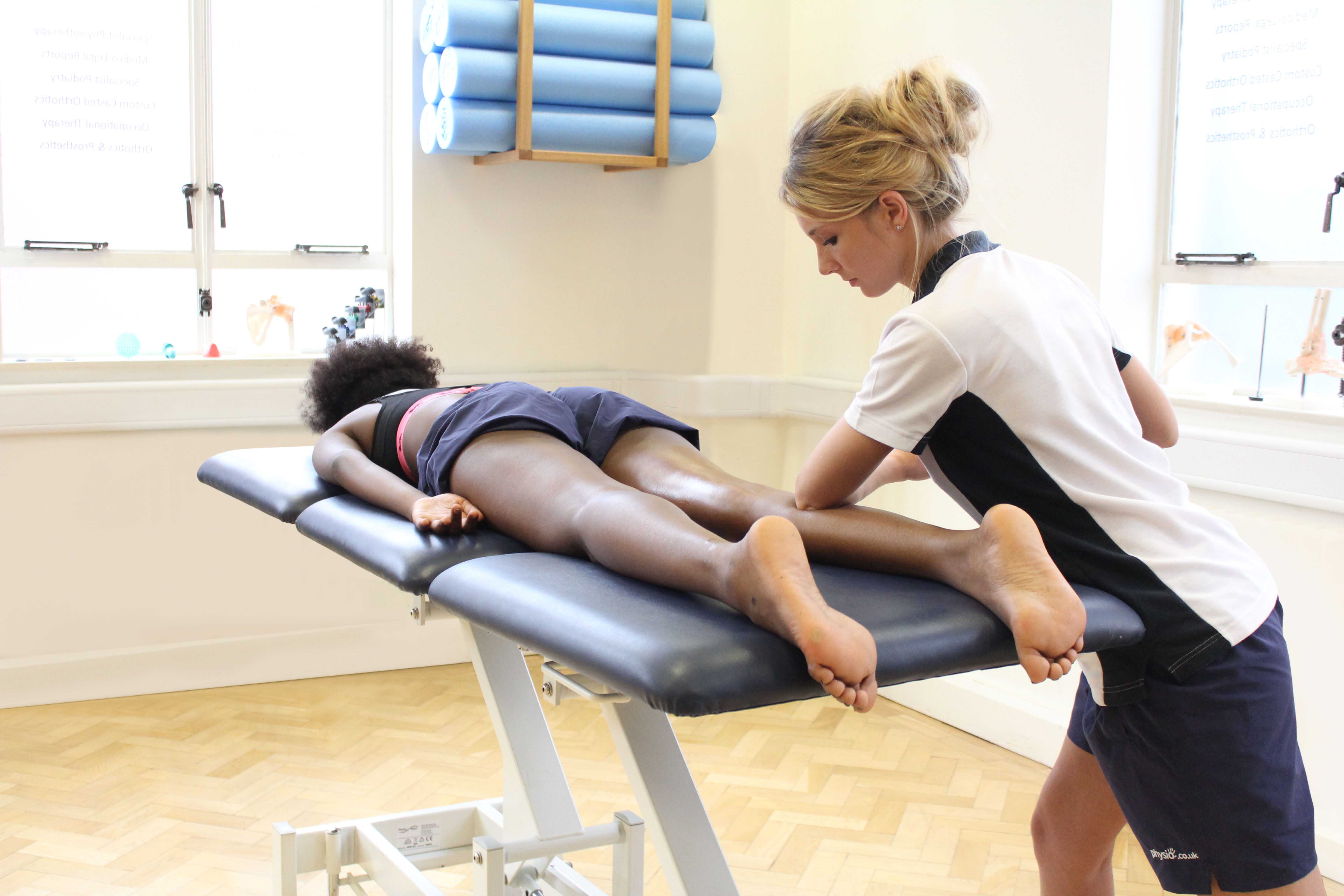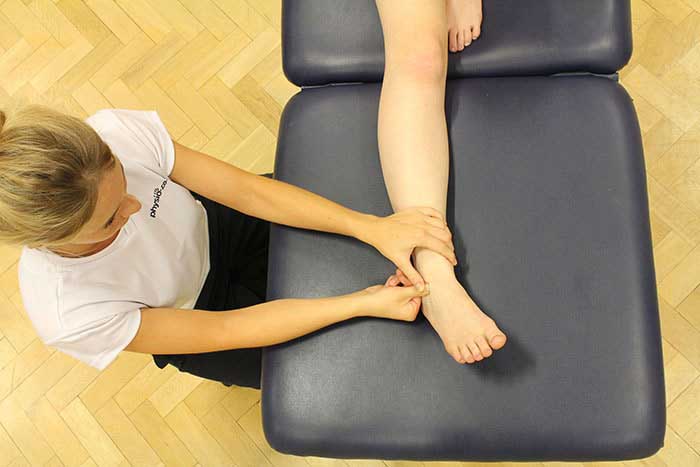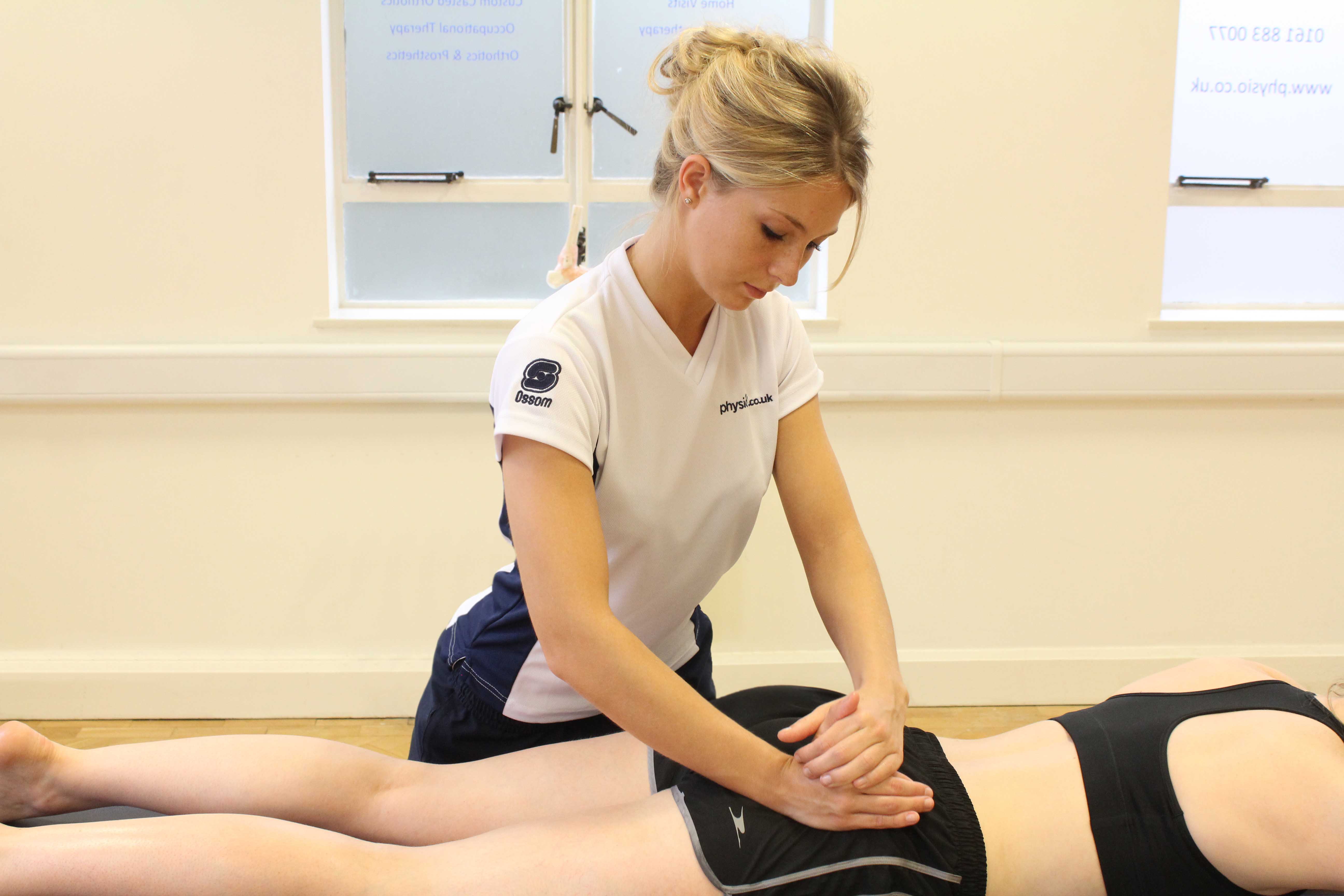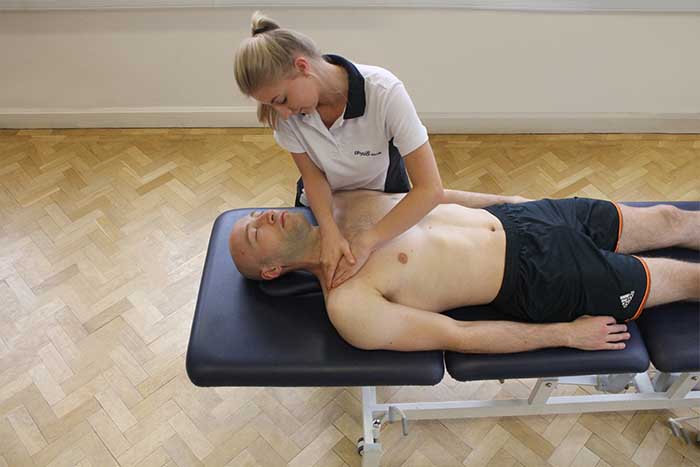A common benefit gained through massage is increased healing. After an injury or surgery a variety of negative effects can occur within the body. Common negative effects that occur after injury or surgery include swelling, pain, muscle tightness and stress. A massage helps to speed up recovery by increasing healing to help reduce the negative effects, allowing a person to return to their normal daily activities. Our massage therapists at Physio.co.uk increase healing through massage to help decrease pain, increase range of movement and increase relaxation.
What are the most appropriate types of massage to increase healing?
Various massage types can be used to help increase healing. The massage types most commonly used to increase healing include:
 Above: Soft tissue massage of gastrocnemius and soleus muscle
Above: Soft tissue massage of gastrocnemius and soleus muscleThe most common types of massage used to increase healing include sports massage, remedial massage and Swedish massage.
A sports massage is often used to increase healing. A sports massage is an intense style massage that focuses on areas of the body containing soft tissues. The pressure used throughout a sports massage varies depending on both personal preference and the condition that needs treating. A sports massage increases healing by encouraging an increase in blood flow around the body, providing essential oxygen and nutrients required for the repair of damaged tissues. A sports massage also helps to break down scar tissue that has built up as a result of trauma or injury. Breaking down scar tissue helps to restore muscles natural movements, increasing relaxation and allowing healing to continue.

Healing can be increased through remedial massage. A remedial massage helps to increase relaxation and improve muscle condition through the manipulation of superficial and deep tissues. A remedial massage aims to repair damaged tissues and fibres to help decrease pain, reduce restriction and increase healing. During a remedial massage, muscles are encouraged to relax and loosen providing a therapeutic effect. Healing can be reduced when muscles are tight and tense, increasing pain and the time taken for the injury to heal. Relaxing muscles therefore improves healing.
A Swedish massage can help increase healing. A Swedish massage encourages relaxation of a person both physically and mentally. Lymphatic drainage is increased whilst tension is reduced, both improving muscle condition and increasing healing. After an injury or trauma, stress levels can increase, affecting a person mentally. Stress can slow down healing. A Swedish massage encourages the release of positive hormones serotonin, dopamine and endorphins which promote relaxation and a sense of well-being whilst also reducing stress. Reducing stress increases healing.
What techniques are used to increase healing?
A wide range of techniques can be used to increase healing. The most common techniques used to increase healing include:
 Above: Soft tissue massage of planta facia
Above: Soft tissue massage of planta facia The techniques most commonly used to increase healing include deep strokes, lymphatic drainage and trigger pointing.
Deep strokes are regularly used throughout a massage to help increase healing. Deep strokes involve using flattened hands and fingers to apply a firm pressure to the treatment area. Deep strokes are used to get into the deeper layers of muscle tissues in order to relieve muscle tightness, tension and stress. Deep strokes can be used to break down adhesions, scar tissue and muscular knots which all restrict movement and slow down the healing process. Deep strokes create friction between the skin and fingers which encourages an increase in blood flow. An increase in blood flow is used to increase muscle temperature as well as a source of oxygen and nutrients to repair damaged fibres. Increasing muscle temperature improves tissue elasticity and softens muscular knots and adhesions. Improving tissue elasticity and softening knots and adhesions, increases range of movement and decreases pain. An increase in range of movement decreases restriction and allows healing to speed up.
Lymphatic drainage is a common technique used to increase healing. Lymphatic drainage is the where waste products and toxins are removed from the body by the stimulation of the lymphatic system. The lymphatic system is consists of a series of tiny lymph vessels. Waste products and toxins are carried within the lymph flow through the lymph vessels towards different glands and nodes located at different points of the body. The most common glands are found in the armpit, groin and behind the knee. After an injury or trauma, a build-up of waste products and toxins often occurs resulting in swelling, muscle fatigue and muscle weakness. Waste products can prevent healing from occurring, increasing pain and stress. A massage promotes the stimulation of the lymphatic system. Stimulating the lymphatic system increases the rate at which waste products are removed through the lymphatic flow. Removing waste products more efficiently from the body reduces swelling and increases muscle strength and health, therefore increasing healing.
Trigger pointing can be used to increase healing. Trigger pointing involves applying a frim pressure to muscular knots using the fingertips or thumbs. Trigger points can be found in the centre of a muscle fibre and can increase pain, restriction and stress if left untreated. Trigger pointing causes an ischemic reaction to occur due to the restriction in blood flow as pressure is applied. Pain will slowly start to ease as pressure is applied to the trigger point, creating a numbing sensation. When the numbing sensation occurs, a deeper pressure can be applied to further break down the knots or pressure can be released. Once pressure has been released an increase in blood flow occurs to help repair damaged tissues. Breaking down trigger points and increasing blood flow help to reduce restriction and increase healing.
When can a massage help to increase healing?
Increasing healing through massage can help in a range of situations. The situations most commonly helped through increased healing include:
The most common situations increasing healing through massage can help include acute pain, post-surgery and relaxation.
Increased healing can help reduce acute pain. When healing is prevented, the effects of injury or trauma can often increase pain levels. Conditions such as inflammation and muscular fatigue often occur which both increase pain. Increasing healing helps to reduce inflammation and fatigue by improving the efficiency of the lymphatic system. A more efficient lymphatic system removes waste products more quickly to help restore a muscles health. Injury and trauma can also increase muscle tightness and tension which also increase pain. Increasing healing helps to relax and loosen muscles with the aim to relieve tightness and tension and increase range of movement. Removing waste products and increasing relaxation both help to reduce pain.
The effects of surgery can be reduced when healing is increased. Surgery can leave damaging effects on a person. One of the most common effects of surgery is lymphedema. Lymphedema occurs after surgery and is where an increase in swelling occurs due to a restriction in lymph flow. When lymph flow is restricted, metabolic wastes build-up around muscles increasing pain and preventing healing. A massage helps to treat lymphedema and increase healing. The lymphatic system is stimulated during a massage. Stimulation of the lymphatic system improves lymph flow. An improvement in lymph flow allows the build-up of metabolic wastes to be removed from the body more quickly. Removing the metabolic wastes decreases inflammation and therefore reduces lymphedema. A reduction in lymphedema decrease pain, increase movement and allows healing to speed up.
Increased healing can increase relaxation. After injury, surgery or trauma relaxation is prevented due to an increase in pain, muscle tightness and muscle tension. When a muscle has been damaged, surrounding muscles often tighten and restrict to protect the body from further damage. Tight and tense muscles increase pain and stress levels, reducing relaxation. During a massage, healing is increased to help repair the damaged muscle. Whilst repairing the muscle, surrounding muscles are encouraged to loosen and relax, relieving muscle tightness and tension. The relief of muscle tightness and tension reduces pain and stress and increases physical and mental relaxation.

What are the physiological effects of massage to increase healing?
A variety of physiological effects occur during a massage to help increase healing. The most common physiological effects that occur include:
The physiological effects that most commonly occur during a massage to increase healing include increased vasodilation, the removal of waste products and the breakdown/realignment of collagen fibres.
Increased vasodilation can help increase healing. Vasodilation involves the relaxation of smooth muscles lining a blood vessel allowing the vessel to dilate. Vasodilation allows an increase in blood flow to and from muscles around the body. Increased vasodilation rises the amount of blood available for damaged muscles and tissues. The blood flow carries healthy oxygen and nutrients which are used for the repair of damaged fibres and tissues. Increasing blood flow through vasodilation allows damaged muscles to be repaired more easily due to the increase in oxygen and nutrients available. Increasing the repair of damaged muscles therefore increases healing.
Healing can be increased through the removal of wasted products. The removal of waste products involves the stimulation of the lymphatic system which removes metabolic wastes and excess fluids from the body through the lymph flow. After injury or trauma, a build-up of waste products can occur due to fatigued and weakened muscles. A build-up of waste products can also cause swelling. Waste products slow down healing and can cause further weakening to the damaged muscles. During a massage, lymphatic circulation is improved. An improvement in lymphatic circulation encourages waste products to be removed more efficiently. Removing waste products from the injury site more efficiently can reduce swelling, increase a muscles strength and improve the muscles health. Allowing a muscle to increase in health and strength increases healing.
The breakdown/realignment of collagen fibres can increase healing. After an injury has occurred, collagen fibres form adhesions that lay haphazardly across a muscle fibre. The aim of adhesions formed by collagen fibres is to repair damaged tissues. Adhesions can often cause restricted movement and prevent full healing. A massage aims to break down and realign collagen fibres in order to remove adhesions and increase movement. During a massage, an increase in temperature occurs within both muscles and collagen fibres. Increasing temperature of collagen fibres allows them to be broken down more easily. After collagen fibres have been broken down, a range of techniques are used to realign the collagen fibres so they are in line with the body's natural muscle fibres. Realigning collagen fibres increases movement and reduces muscle tightness and tension therefore allowing healing to improve.
Summary
Increased healing involves strengthening, loosening and relaxing muscles damaged through injury or surgery. Many different massage types can be used to increase healing including sports massage, remedial massage and Swedish massage. Within a massage, a range of techniques are used to increase healing including deep strokes, lymphatic drainage and trigger pointing. Increased healing through massage can help acute pain, post-surgery and relaxation. A range of physiological effects including increased vasodilation, the removal of waste products and the breakdown/realignment of collagen fibres all occur during a massage to help increase healing. Our massage therapists at Physio.co.uk increase healing through massage to help improve recover, reduce stress and increase range of movement.
How can I arrange a massage to increase healing?
The easiest way to arrange a massage to increase healing at Physio.co.uk is to email us at office@physio.co.uk or call us on 0800 033 7800.
You can also book an appointment online and save £10

 0330 088 7800
0330 088 7800






































